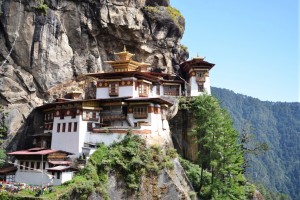
1.Taktsang (Tiger’s Nest) Monastery
The Tiger’s Nest is without a doubt the most visited and the most photographed of all the monuments in Bhutan. Nestled on the edge of a 3,120m-tall cliff, above a beautiful forest of blue pine and rhododendrons, overlooking the Paro valley, the monastery is of tremendous religious significance to the Bhutanese. Legend has it that Guru Rinpoche flew to this site on the back of a tigress to subdue a local demon. Thereafter, he meditated here for three years, three months and three hours. It was here that Buddhism took roots in Bhutan. The monastery was built in 1692 to honor and worship the Guru. The hike up to the Tiger’s Nest is give-or-take a two-hour ascent and, the view from the top, is well worth the climb.
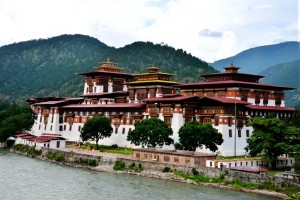
2.Punakha Dzong (via Dochula Pass)
Standing majestically at the confluence of the Pho Chhu and Mo Chhu rivers, the dzong (fortress) was constructed in 1637-38 and is the second oldest dzong in the Kingdom. The dzong houses the sacred relics of the southern Drukpa Lineage of the Kagyu school of Tibetan Buddhism, including the Rangjung Kasarpani and the sacred remains of Ngawang Namgyal and the terton Pema Lingpa. It was the administrative centre and the seat of the Bhutanese government until 1955, when the capital was moved to Thimphu. Today, it is still the winter residence of the Je Khenpo (Chief Abbot) and the monastic body of Bhutan. Set against a spectacular backdrop, the architecture of the dzong is simply awe inspiring. It was in Punakha dzong that the wedding of His Majesty King Jigme Khesar Namgyel Wangchuck and Her Majesty Queen Jetsun Pema was held on October 13, 2011.
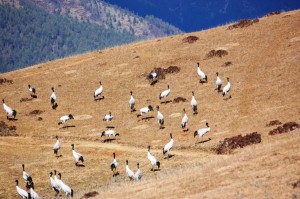
3.Gangtey/Phobjikha Valley
The Gangtey Gonpa or Gangtey Monastery is bounded on the west side by the Black Mountains (above 5,000 meters). This monastery in Wangdue Phodrang district in central Bhutan is located on a spur amidst the Gangtey village, overlooking the vast Phobjika Valley. The monastery commands striking views of the Valley where the Black Mountain region is inhabited by nomadic shepherds and yak-herders. Gangtey Gonpa is an important monastery of the Nyingmapa school of Buddhism, the main seat of the Pema Lingpa tradition.
During the winter months, the Crane Festival marks the arrival of Black-necked Cranes from the Tibetan plateau. The sacred birds that migrate here are held as a religious blessing by the people, and their arrival is a big event not only in the Valley but also in this monastery. The Black-Necked Crane Festival is held on November 12, every year.
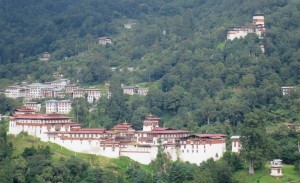
4.Trongsa Dzong and Ta Dzong (Museum)
Trongsa Dzong is a grand, massive structure and one of the most strategically posed Dzongs in Bhutan. All the five Kings of Bhutan were invested as Trongsa Penlop (“governor”) before the ascending the throne while the First and Second Kings of Bhutan ruled the kingdom from here.
The Dzong is also positioned on the only connecting route between east and west therefore this gave the Trongsa Penlop effective control over the central and eastern regions.
Additionally, the Ta Dzong was the watch tower which once guarded Trongsa Dzong from internal rebellion. It stands on a promontory above the town and as of now has been converted into the most fascinating museum of the nation. It provides visitors an insight into the significance of Trongsa in Bhutan’s history.
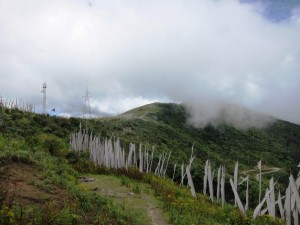
5.Haa Valley (via Chelela Pass)
Haa is the smallest Dzongkhag in Bhutan and one of the most isolated. You must travel two hours by road and cross the Chelela mountain pass, Bhutan’s highest road pass to get to Haa. With its virtually untouched forests and ancient trails, it is an ideal location for Himalayan hiking.
The mountain slopes are covered in fields of white poppy (endemic to Haa and not found anywhere else in the world), dense forests of fir trees and several varieties of ferns. You also get to enjoy the beauty of pristine lakes thriving with rainbow trout.
Standing sentinel at the south entrance of the valley are the two temples – Lhakhang Karpo (White Temple) and Lhakhang Nagpo (Black Temple). Legend has it that the Tibetan King Songsten Gempo released a white and a black pigeon so that wherever they landed would stand the respective temples. These two are among the 108 temples built by the King. An added attraction is the Haa Summer Festival which showcases the unique culture and traditions of the nomadic Haaps.

